|
Following
Gandhi's Path - Part 8
Mr.
Bakhta relives the Salt March
By Jan
Oberg
TFF director
From Surat towards
the Sea
Surat is located to the south of Ahmedabad. I arrive
there by train and hire a car with a driver called Max,
who is as black as an African. I have brought along
Tom Weber's
book on the Salt Marsch, my little computer and my
camera. This trip must be registered thoroughly. I shall
drive the final 50 kilometres of Gandhi's Salt March
along small roads from one village to the next, and visit
the temples, overnight accommodations and other places
the 78 marchers passed 71 years ago.
We soon leave "development" and "civilisation" behind
us. India is its villages, not its cities! Here it is
pastoral and peaceful; the air is fresh. I can both see
and hear the birds. In the small village of Dharam, I
find a simple house, now a library, which has a statue of
Gandhi erected in front of it. The marchers had spent a
night here.
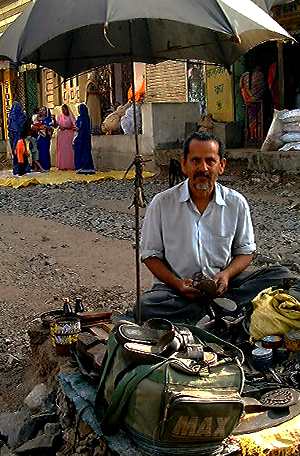
Photo Jan Öberg, © TFF
2001
Shoemaker outside Surat
I enter the library. Max talks to someone and comes
back with some news, "they say there is an old friend of
Gandhi living here at Dharam, a person who was with him
during the march. Would you like to see him?" Oh,
certainly, I think rather sceptically. Many have sold
their services to the tourist industry as supposed
friends of the great, little man.
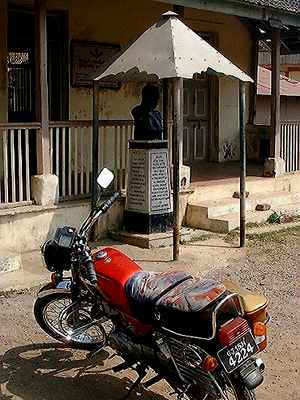
Photo Jan Öberg, © TFF
2001
Gandhi's bust in front of the
library in Dharam
Mr. Bakhta lives with one of his grandchildren. His
wife is dead, and he himself is now 94 years old.
"I was 23 and a freedom-fighter when we did the March.
I was studying history at Gujarat Vidyapith (University),
which Gandhi founded. Then I came to his Sabarmati-ashram
and was fascinated by it.
"I joined a group that travelled ahead of Gandhi and
planned night accommodations, rallies, etc. We were ready
to die for the independence of India. That's how it must
be if you really want to achieve something, but as you
see I'm still alive!"
He laughs. I ask him about today's India.
"Oh my, today's India is a catastrophe, not at all
what we were fighting for. Nehru was alright, but Indira
Gandhi destroyed both the country and the vision we had
of it. I'm not bitter. I did what I did because I thought
it was right. Things just did not turn out the way I had
hoped they would."
He shows me pictures of the three letters he and
Gandhi wrote to each other. The contents are not of
special interest, he says, but Gandhi answered every
letter he received. I thanked him and said it was a great
pleasure to have met and worked for him.
"Thank you very much", he says, "but where are you
heading to now?" I tell him that we are going to the
seaside, to the village of Dandi, where Gandhi had picked
up some salt thereby altering the fate of India and of
the world, and that thereafter we are going to see the
salt works of Dharasana, which are very important goals
on my journey through India.
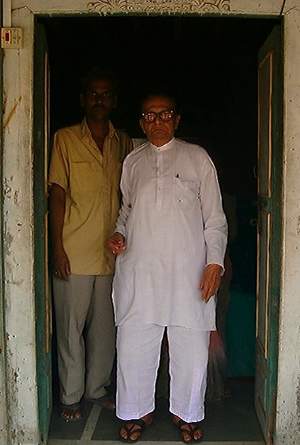
Photo Jan Öberg, © TFF
2001
Mr. Bakhta in his house at
Dharam
"I'd love to go with you, would that be possible?"
Completely surprised, I say, "Yes, of course!" and
realise immediately that 94 years, 35 degrees Celsius and
a humid climate might be a dangerous combination. To his
family he says that he is going to show us a school just
ten kilometres away.
He changes his shirt and his family help him to come
out to the car. Off we go, driving on tiny paths,
together with millions of other people and bicycles,
toward the coast of the Arabian Sea. What a feeling! We
breathe in the sea air, look at the monument, visit the
little March Museum at Dandi. There is as little salt
here now as there was in Gandhi's day. As far as the eye
can see, there are dark brown shores, playing children
and holiday makers.
We have to travel 47 hopeless kilometres to the salt
works. If you have seen the film about Gandhi, you will
remember the rows of demonstrators and marchers who were
knocked down by the police. Hundreds of them were taken
to the hospital bleeding from their injuries. Mr. Bakhta
was one of them.
We drink some tea and get something to eat. Mr. Bakhta
is in a cheerful mood and tells us a little of
everything: what the road was like before it was
asphalted, how deadly tired they were, how much they were
prepared to be arrested at any moment, Gandhi's
temperament.
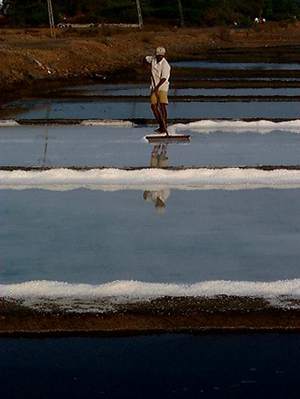
Photo Jan Öberg, © TFF
2001
The salt works in Dharasana
Late in the afternoon as the sun is setting, we reach
the salt works in Dharasana. The salt is contained in
large squares bordered by salt-banks. Water and salt
reflect the sun and the sky marvellously. Bare-foot
salt-workers shovel the salt back and forth towards the
banks. We explain to them that we are interested in
Gandhi and the story of salt. Then we ask them to let us
take some salt as a souvenir and we take some also for
Mr. Bakhta who has stayed behind in the car.
When we return I see a tear rolling down his cheek. I
look at him with a careful, inquiring look and then he
says:
"I'm so happy I came along; I really am. You know,
it's only the second time I have been here".
I look at him in surprise.
"I mean I was here in 1930 and now today. I haven't
been back since all that happened here".
Now I realise why he had only mentioned the school he
had founded and showed us on the way. If he had told his
family he was going to travel 200 kilometres in this
heat, they would hardly have let him go. But reliving the
memory of the Salt March was really irresistible to him
at the age of 94. And a day came with a car, a driver and
a Gandhi enthusiast.
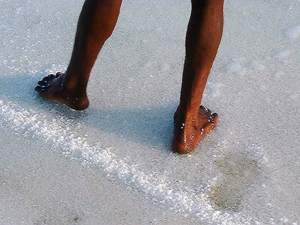
Photo Jan Öberg, © TFF
2001
"Salt feet"
When we return in the evening Mr Bakhta is very tired
but very happy. We thank each other heartily. We had
shared quite the experience today, on that march
route.
But Mr. Bakhta had forgotten his salt in the car. So
we return it to him, to his great pleasure. Who should
have that salt if not Mr. Bakhta, who had been ready to
sacrifice his life to change history and demolish British
colonial power?
The salt reminds us that symbol-politics and
non-violence can be stronger than realpolitik and
violence. Or so it was then, at any rate. Afterwards,
things in India turned out different than what Gandhi or
Bakhta had hoped for. In India, as in today's Sweden,
there is a shortage of both salt and the kind of courage
they had.
Translated by Alice
Moncada
Translation edited by Sara E. Ellis
Other
articles about India, "Following Gandhi's Path" and
picture galleries
©
TFF 2002

Tell a friend about this article
Send to:
From:
Message and your name
|